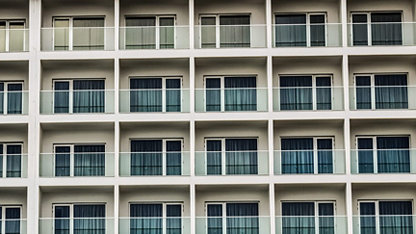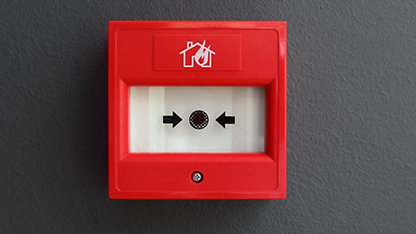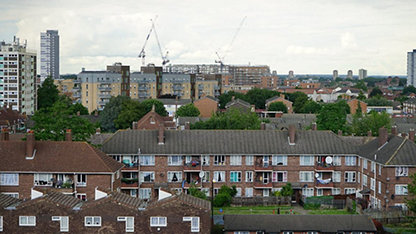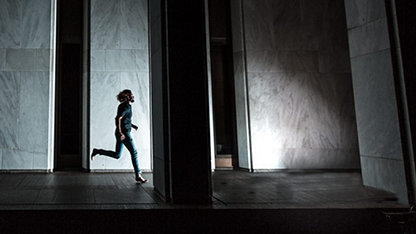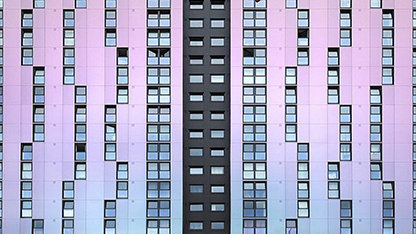Ensuring fire safety can be problematic when dealing with flat entrance doors. Gary Strong offers advice on the regulatory regime.
Since the Grenfell Tower tragedy, responsible owners and managing agents have been carefully reviewing their fire risk assessments (FRAs), which are necessary under the Regulatory Reform (Fire Safety) Order 2005.
RICS now recommends that for all high-risk buildings – residential tower blocks and buildings more than 18m in height, care homes, hotels, student accommodation and hospitals – that an FRA is conducted annually, and in all other buildings the assessment is reviewed at least once a year, with no more than a five-year interval between new FRAs.
Fielding enquiries
RICS has been fielding enquiries in relation to entrance doors to flats that open on to common parts such as staircases or corridors, and how to deal with these during upgrading works or when door replacement is deemed necessary following inspection and the publication of an FRA.
In high-risk buildings, RICS now recommends that monthly visual inspections of the building are carried out to ensure that fire doors are not compromised. In some instances, leasehold owners of flats have replaced what were originally fire doors with new ones that are not fire-resistant, thus compromising the compartmentation of the block.
Enforcing the upgrade or replacement of doors can also prove difficult when the lease specifically refers to the entrance door of the flat as being within the demise of the flat – that is, it is the leaseholder’s responsibility – and it is not under the control of the freeholder.
So, what can be done?
Basic principles
On 8 October 2017, all local authority chief executives were sent a letter by Neil O’Connor, the Building Safety Programme Director at the Department for Communities and Local Government, which is now renamed the Ministry for Housing, Communities and Local Government (MHCLG).
Although his letter primarily concerned potentially combustible cladding on the exterior of residential tower blocks, it is worth reminding readers of the basic principles it sets out that apply as these may help in certain circumstances.
MHCLG’s view is that local authority powers under this regime are available in respect of the external cladding systems of tall residential buildings. But it has also reminded authorities of additional enforcement powers that may be available in some circumstances, and they will need to consider the details of each particular case.
RICS would further remind readers of existing guidance such as that on the housing health and safety rating system (HHSRS).
MHCLG’s considered position is that the Housing Act 2004, the Housing Health and Safety Rating System (England) Regulations 2005, and both sets of statutory guidance made pursuant to the 2004 act – which together comprise the HHSRS regime – are clearly designed to ensure the safety of residents in relation to a range of prescribed hazards, including fire. Many of these hazards will derive from the construction of the wider fabric of residential buildings external to individual dwelling units.
The ministry’s view is the safety of any cladding system fitted to the common parts of a residential building, whether in respect of fire or structural integrity, is entirely in the scope of the HHSRS regime and amenable to statutory enforcement in appropriate cases, and the relevant powers can be considered and deployed with other potential enforcement action as identified above. It follows therefore that the internal common parts and fire doors of buildings also fall under this scope.
The provisions of the 2004 act are considered by MHCLG to be available in principle so local authorities can inspect and take enforcement action in respect of cladding where this poses a hazard under the HHSRS. RICS interprets this wider, insofar as entrance doors to flats that are not fire-resistant could also be a hazard under the HHSRS.
MHCLG’s view is that the regime is targeted more broadly than the individual units of occupation in a block. The legislation is designed with a number of different purposes in mind, not all of which are dealt with expressly in guidance, and there are no grounds for considering that the external cladding on a building or any other aspects of fire hazard is not covered by the regime.
Taking samples for testing, if necessary under warrant, would fall under the regime, as well as housing authorities’ enforcement powers under that regime at part 1 and 7 of the 2004 act.
There are many examples in the legislation and guidance supporting the view that this is the only sensible interpretation.
The 2004 act
Under the 2004 act, the section 1(4) definition of residential premises includes any common parts of a building containing one or more flats. The section 1(5) definition of common parts expressly includes the structure and exterior of the building and therefore includes a cladding system on a residential block, which is part of the exterior of a building, and any doors in the common parts.
The definition of hazard at section 2(1) includes health and safety risks arising from a deficiency in a dwelling or in any building or land in the vicinity, which clearly goes beyond individual dwelling units.
The enforcement powers available to local authorities, in particular those at section 239 and section 240 of the act, among other relevant powers, must be interpreted in line with these earlier definitions in the act that include common parts; thus the powers are available in respect of anything that might pose a hazard.
Prescribed hazards
Regulation 3(1) and paragraph 24 of Schedule 1 of the Housing Health and Safety Rating System (England) Regulations 2005 define a prescribed hazard for the purposes of the 2004 act as including exposure to uncontrolled fire and associated smoke. Exposure to such a hazard is not confined to matters arising, for example, from the construction of elements in an individual dwelling unit, but will include aspects of the wider fabric of the building or structure in which the unit is located.
In Schedule 1 there are other examples of prescribed hazards that will likely derive from the wider fabric of a building, including paragraph 29, “structural collapse and falling elements”. Such hazards clearly require consideration and inspection of a building’s wider structural elements.
Indeed, if there were – for example – potential for cladding panels to fall from a building because of defects or deterioration in their fixings, this matter would be in the ambit of the hazards defined by paragraph 29. There can be no valid reason to exclude these from consideration of any exposure to uncontrolled fire and smoke that they might present.
Regulation 3(2) prescribes that the risk of harm arising from hazard may be at a dwelling or house in multiple occupation (HMO), or “in any building or land in the vicinity of the dwelling or HMO”. Again, it is clear that a hazard is not confined to circumstances obtaining in an individual dwelling unit, but is defined in much wider terms consistent with the provisions in the 2004 act mentioned above.
In relation to the requirement to consult with fire and rescue authorities imposed by section 10 of the 2004 act, regulation 4 prescribes that a fire hazard occurs where the risk of harm is related to exposure to uncontrolled fire and associated smoke. This duty is not restricted to circumstances that concern only an individual dwelling unit.
Even if there were ambiguity in the interpretation of provisions of the 2004 act and underlying regulations – and MHCLG does not consider that there is such ambiguity – the regime as a whole must be interpreted purposively so as to ensure the safety of residences in respect of fire hazards. In any event, MHCLG’s interpretation of the primary legislation, as set out above, is also confirmed by the statutory guidance issued pursuant to section 9 of the 2004 act.
Operating guidance
At paragraph 1.1.2 of the HHSRS operating guidance it states: “the underlying principles of the HHSRS is that – Any residential premises should provide a safe and healthy environment for any potential occupier or visitor”.
Paragraph 1.13 of the guidance is explicit that the materials with which a dwelling is constructed fall under the regime; it follows that flat entrance doors are in the scope of the rating system.
Paragraph 4.03 meanwhile makes clear that the external parts of the dwelling are expressly covered in the context of inspections.
At paragraph 5.03, the list of what should be in an assessment includes, at sub-paragraph (d), “the building associated with the dwelling”; that is, it encompasses the wider fabric of a building that may contain several individual dwelling units.
Paragraphs B17 to B19 of Annex B of the Operating Guidance, “Inspections for an HHSRS Assessment”, explicitly mention the exterior of the building. Paragraph 29.01 of Annex D of the guidance, “Profiles of potential health and safety hazards in dwellings”, meanwhile requires assessment of the structure of the building. Although this is about the risks of fabric being displaced or falling, it shows that all aspects of the building fall in the scope of an assessment.
Enforcement guidance
In the HHSRS enforcement guidance, paragraphs 6.6–6.11 specifically contemplate deficiencies in any individual dwelling unit leading to enforcement action against the wider building owners. In particular, paragraph 6.9 deals expressly with a deficiency relating to the structure that should be addressed by serving a notice on the person who owns the building.
It follows from the above that MHCLG considers there should be no doubt about the ability to use the enforcement powers under the 2004 act to address deficiencies that may give rise to fire hazards.
In addition, there are other relevant enforcement powers, summarised below.
Building Act 1984
Where building work has been carried out in breach of the Building Regulations, especially where it has been recently completed, local authority building control bodies may take one of the following courses of action.
- Enter any premises at reasonable hours for the purpose of undertaking their functions under the Building Act 1984 and Building Regulations. This includes ascertaining whether there is, or has been, a contravention of the act or of any regulations, and to take any action or execute works these require where the local authority is authorised or required to do so, under section 95 of the act. If admission to the premises is refused, a justice of the peace may issue a warrant under section 95(3) and 93(4).
- Serve an enforcement notice on a building owner to require the removal or alteration of work that does not comply with the Building Regulations under section 36(1) of the act. Such a notice must be served within 12 months of the date of completion of the building works in question, as per section 36(4). If the owner does not comply with the enforcement notice, the local authority may itself take action to remove the offending work or effect such alterations in it as it deems necessary, under section 36
- Prosecute contraventions of the Building Regulations through summary proceedings in the magistrates’ court under section 35 within six months of the breach being discovered, provided that action is taken within two years of completion of the building work that is in breach, under section 35A.
However, it is of course for each local housing authority, building owner and managing agent to make its own decision about what is lawful on a case-by-case basis, and to take legal advice where necessary. Approaches should always be made to the leaseholders about defective doors at first, but ultimately it may be necessary to ask the local authority to step in and take enforcement action.
Any enforcement action taken by local authorities under the 2004 act can be challenged on appeal to the First-tier Tribunal in the first instance, and it is for the tribunal and the courts to make any final determination about the application of these provisions on a case-by-case basis.
Further advice
I hope you find the above helpful in dealing with non-fire-resistant flat entrance doors or any other aspects of a building that represent a hazard. If you have any further questions, please email.
Gary Strong FRICS is RICS Global Building Standards Director.
This article first appeared in RICS Building Control Journal (June/July 2018).


